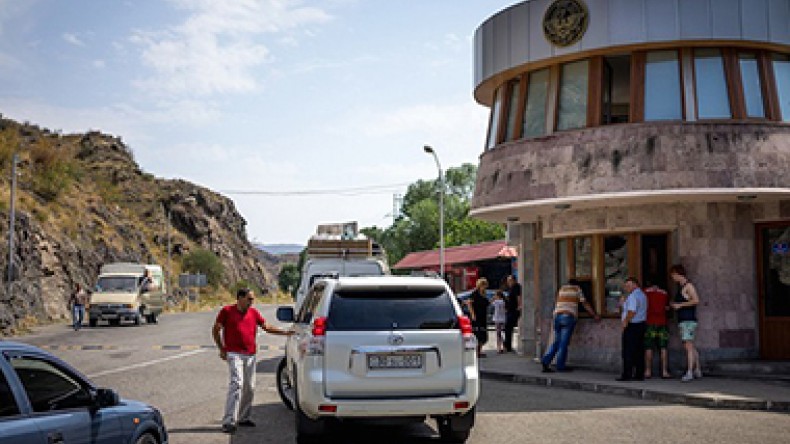
The Calvert Journal: Dark picture painted by news headlines covering Nagorno Karabakh is forgotten once one arrives
The Nagorno-Karabakh Republic is a territory nestled in the mountains between Armenia and Azerbaijan. The landscape here is beautiful but the locals live with the spectre of war constantly hanging over them. A ceasefire from 1994 creaks uneasily while Armenian and Azerbaijani troops remain permanently stationed on Karabakh's eastern border, in trenches just 150 metres apart, writes Richard Ensor, the journalist of the British website The Calvert Journal.
The guards of Nagorno Karabakh greet the guests with neither guns nor aggression, but instead with the warmth that Armenians seem to display to westerners at all times. After the border checkpoint, the car starts twisting through the mountains again and the crucifix hanging below the rearview mirror flings itself left and right. The driver answered Richard and his friend’s questions: “The people living here, they use Armenian currency, they have Armenian passports, they speak Armenian, they are Armenian…” he said, “But it's complicated.”
Karabakh had its bloodiest week in August 2014 just before the journalist and his friend began their journey in the Armenian capital of Yerevan. Twenty soldiers died in border skirmishes, Azerbaijan's President threatened war via his Twitter handle, and foreign governments issued travel warnings regarding Nagorno Karabakh.
“…yet the dark picture painted by news headlines was forgotten once we arrived,” the journalist writes noting that, in fact, the mood was almost festive. Blessed with beautiful weather, Karabakh would celebrate its 21st birthday in a few days. The locals were not too concerned about the recent fighting. “The people here are used to it by now. It's a part of life,” a passenger told the journalist.
As the author has it, in this part of the world, relationships are everything. Armenians are famed for their fierce hospitality, and new acquaintances can become close friendships at a frightening pace. The more obliging tourists here often find themselves accepting invitations to family picnics and drinking sessions from locals, trying in vain to prevent their vodka glasses from being lovingly refilled. Two Armenian men sitting in the front of their car, Tigran and Asqanaz, invited the journalist and his friend to a pool party in the mountains near Stepanakert, Karabakh's capital. They were attending a private celebration between Karabakhti men, a feast for their friend who was getting married the following day.
Ensor writes that a few years ago the Karabakh government started paying its citizens to marry each other and have children. The idea came from Karabakh-born businessman Levon Hairapetian who in 2008 sponsored a mass wedding in Stepanakert for 700 couples in an extraordinary ceremony that courted international attention. Now the region's birth rate is up 30% from the previous decade.
Coming back to the topic of the stag party, the author adds that it was a day for men who delivered toasts on the importance of mothers (“You need to have a good mother to become a good man”), children (“You care about this, you care about that, but then one day you have a child and you realise that nothing else matters”), and ethno-patriotism (“Some of us are from Karabakh, some are not, but we need to remember that we are all Armenians.”)
One of the men at the table was missing an eye, while another had a prosthetic leg. “These guys, they all work for the HALO Trust,” Asqanaz later explained to the journalist. Their job is to remove land mines that are still there from the war so the land can once again be used for farming. It's extremely dangerous work: Karabakh has one of the highest land mine accident rates in the world, and the region's political status makes it difficult for NGOs to obtain funds to remove the remaining mines. “Not everyone who should be with us here today is still alive,” added Asqanaz.
On the next day, they hitchhiked to Tigranakert, an ancient city from before the time of Christ whose ruins were only discovered in 2005. After climbing a mountain near the small, abandoned Vankasar Monastery, they surveyed the view as vultures fly overheard. Just beyond the mist on the horizon, villagers in Azerbaijan's most western settlements are going about their lives. In the 1st century, before Armenia became the world's first Christian nation, this old stone building was a guard tower. If the guards saw an enemy approaching in the valleys below, they would ring the bells: other towers nearby would follow suit and the warning would soon reach the heart of Armenia.
“We enter the monastery and see an Armenian-language bible at the altar, along with a few small pictures of Jesus and extinguished candles. Someone has been here, praying,” the author writes.
Related:
Your Central Valley: Monument ‘Tatik-Papik’ is symbol of victory in Nagorno Karabakh war
British Journal: Nagorno Karabakh populated with Armenians could become the new wonder of world
Newsfeed
Videos






























